 |
 |
 |
| |
Model Says Treating Only 75 of 1000 PWID 7.5% Would Eliminate HCV in This Group
|
| |
| |
EASL Congress 2024, June 5-8, 2004, Milan
"In the USA we are far behind and are not going to reach that goal for 2030"
Mark Mascolini
If at least 7.5% of people who inject drugs (PWID) in the Chicago area (75 of every 1000 PWID) use direct-acting antivirals (DAAs), HCV would be eliminated from that population in 10 years, according to results of a modeling study at the University of Chicago, Loyola University Chicago, and collaborating centers [1]. If DAAs eliminate HCV from PWID in 10 years, a DAA treatment enrollment rate of at least 0.5%-and unrestricted retreatment-would be needed after 10 years to maintain the WHO elimination goal of at least a 90% drop in new HCV infections (incidence).
Current DAA combinations clear HCV infection in a very high proportion of people, including PWID. But high HCV reinfection rates among PWID mean they must have access to multiple rounds of DAA therapy. Hitting the WHO 2030 target is an immense challenge in many groups throughout the world. Some public health experts fear that reaching the lofty WHO goal will lead to complacency and lower funding that would thwart repeated DAA treatment of PWID.
Chicago researchers used HepCEP (Hepatitis C Elimination in PWID), an agent-based model [2], to explore the impact of varying levels of enrollment in DAA treatment by PWID in the Chicago area and to estimate the effect of withdrawing access to DAAs if this PWID population reaches the WHO goal. The investigators modeled a population of 32,000 PWID, 46% living in Chicago and 54% in Chicago suburbs, 70% male and 30% female, averaging 35.3 years in age. Most people in this model, 58%, were white, 21% black, 18% Hispanic, and 3% some other race or ethnicity. About one third of the modeled population had acute or chronic HCV infection, and 13% had recovered from infection. This population had injected drugs for an average 11.4 years, and 19% practiced receptive needle sharing.
The HepCEP model posits HCV-contaminated needles as the transmission vector and sees individuals in the population transitioning from (1) HCV-naive to (2) primary acute infection, (3) recovered from infection, (4) secondary acute infection, and (5) chronic HCV infection [3] (Figure 1 in Reference [3] graphically depicts the model.) DAA therapy can drive transmission from one stage to another by curing HCV infection or failing.
HepCEP uses mathematical modeling to determine probabilities of HCV transmission according to HCV RNA levels of infected PWID who share syringes. The model also considers the HCV transmission impact of acute infection phases (self-clearing, incomplete control, persistence) and reinfection phases (low HCV RNA level with rapid clearance, high HCV RNA level with rapid clearance, chronic infection). (Figure 3 in Reference [3] gives a sample timeline for periods of HCV infection, DAA therapy, and cure or failure in a hypothetical individual.)
The Chicago team modeled DAA treatment enrollment as an unbiased random sample of chronically HCV-infected PWID from a total population of 32,000 PWID. They determined that the annual target DAA enrollment rate is total annual treatment enrollment as a fraction of the total PWID population. For example, a 10% enrollment rate (x 32,000 PWID) would yield 3200 individuals enrolled in DAA therapy yearly. The model considers DAA therapy as starting in year 0 and subsequently available for at least 10 years. But that availability period is followed by a period of decreasing or no availability. Treatment enrollment in the model rests on two assumptions rarely or only occasionally encountered in real-world care: (1) All infected PWID can be identified. (2) Repeat DAA courses are unrestricted [3].
The HepCEP model determined that treating too few PWID with DAA-2.5% enrollment-leaves the door open to rising HCV incidence because increased numbers of HCV-susceptible PWID (newly infected or reinfected) would outpace the treatment rate. The model also figured that 2.5% enrollment would slightly lower HCV prevalence in this population. If DAA treatment stops completely after year 10, HepCEP projected that new cases of HCV infection in this community would return to year 0 levels (that is, before DAA therapy began) within 5 years,.
The model predicts that the WHO HCV incidence target can be reached in 10 years in this PWID population if DAA enrollment rates rise to at least 7.5% (75 DAA courses for every 1000 PWID). If the WHO HCV elimination goal is reached with DAA treatment enrollment of 7.5% from year 0 through 10, the model predicted that microelimination of HCV in this PWID population could be sustained with a DAA target of at least 0.5%.
Based on their modeling projections, the Chicago collaborators believe greater than 7.5% scale-up of DAAs by PWID is essential to meet the WHO goal of 90% lower HCV incidence within 10 years in their PWID study population. "Unrestricted re-treatment with enrollment rates of [at least] 7.5% should remain beyond 2030," they urged, "to maintain the WHO elimination goal and prevent resurgence of HCV incidence to current levels."
References
1. Tatara E, Shekhtman L, Collier N, et al. What happens to HCV incidence after WHO elimination goal is met? Agent-based modeling predicts sustained availability of direct-acting antivirals among people who inject drugs is required to prevent returning to pre-elimination levels. EASL Congress 2024, June 5-8, 2004, Milan. Abstract OS-063.
2. Tatara E, Collier NT, Ozik J, et al. Multi-objective model exploration of hepatitis C elimination in an agent-based model of people who inject drugs. Proc Winter Simul Conf. 2019:2019:1008-1019. doi: 10.1109/wsc40007.2019.9004747. >https://www.ncbi.nlm.nih.gov/pmc/articles/PMC7335458/
3. Tatara E, Gutfraind A, Collier NT, et al. Modeling hepatitis C micro-elimination among people who inject drugs with direct-acting antivirals in metropolitan Chicago. PLoS One. 2022;17:e0264983. doi: 10.1371/journal.pone.0264983.
https://journals.plos.org/plosone/article?id=10.1371/journal.pone.0264983
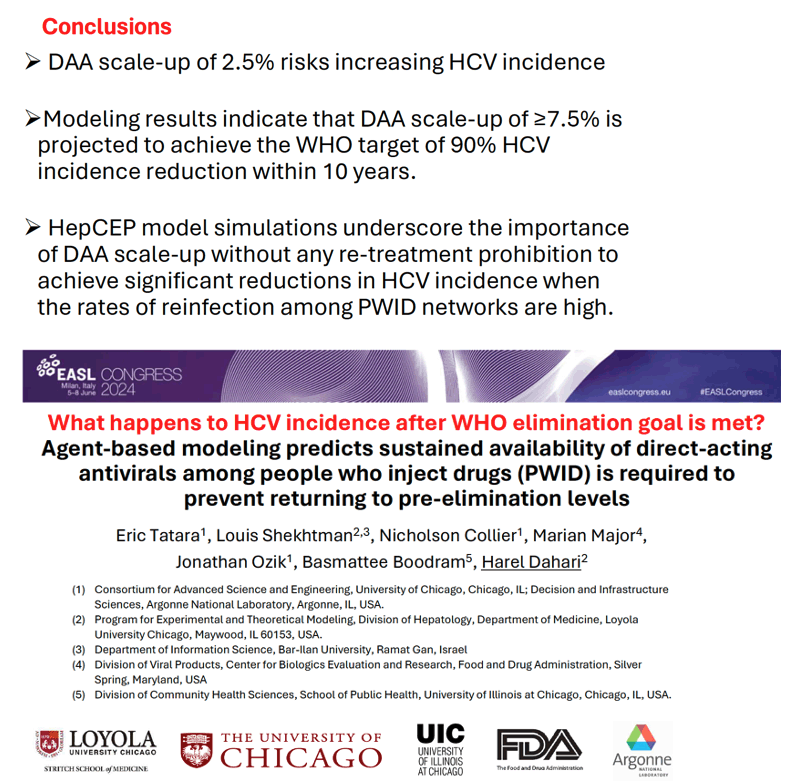
The model predicts that elimination can be achieved in the PWID population by 2030 for DAA enrollment rates >= 7.5% (75 per 1000 PWID). When DAA treatment is stopped in 2030, the rate of new chronic HCV infections rapidly increases and exceeds the WHO 2030 goal within 12 months, regardless of the enrollment rate prior to 2030.
Conclusion: Modeling results indicate that DAA scale-up of >7.5% is projected to achieve the WHO target of 90% HCV incidence reduction by 2030
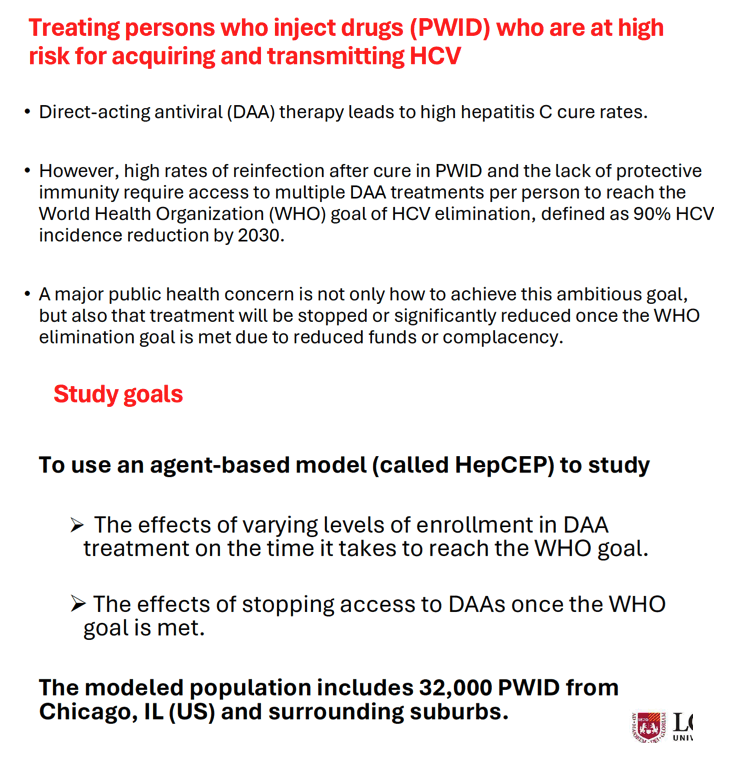

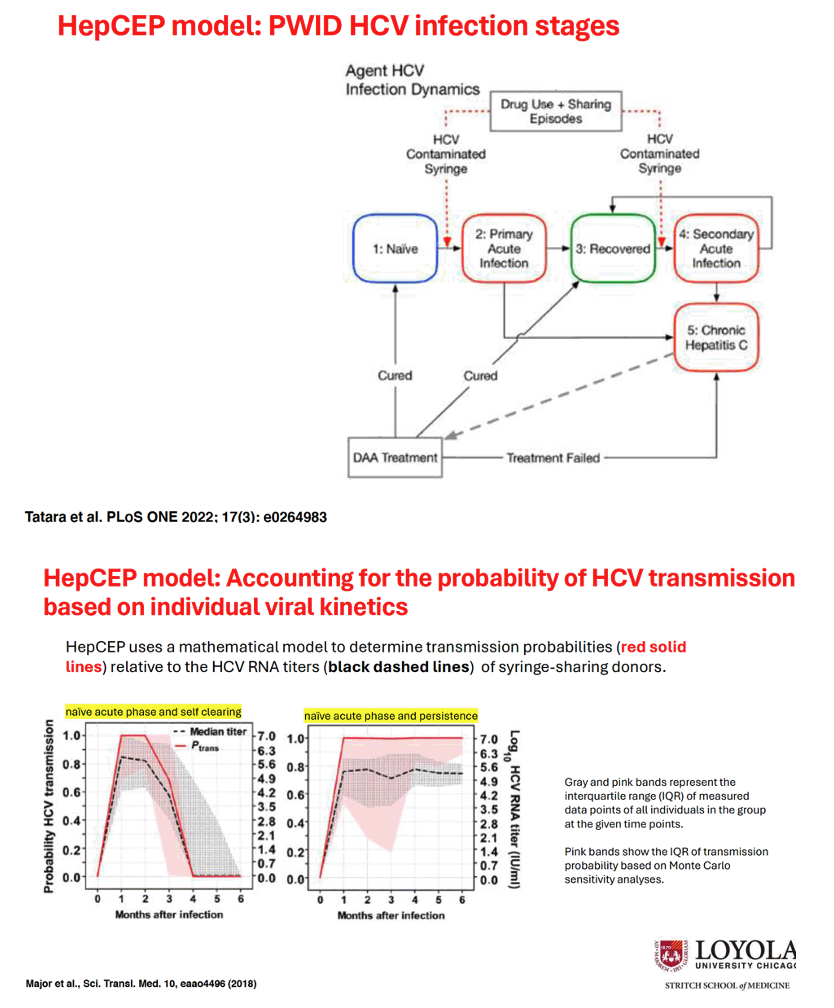
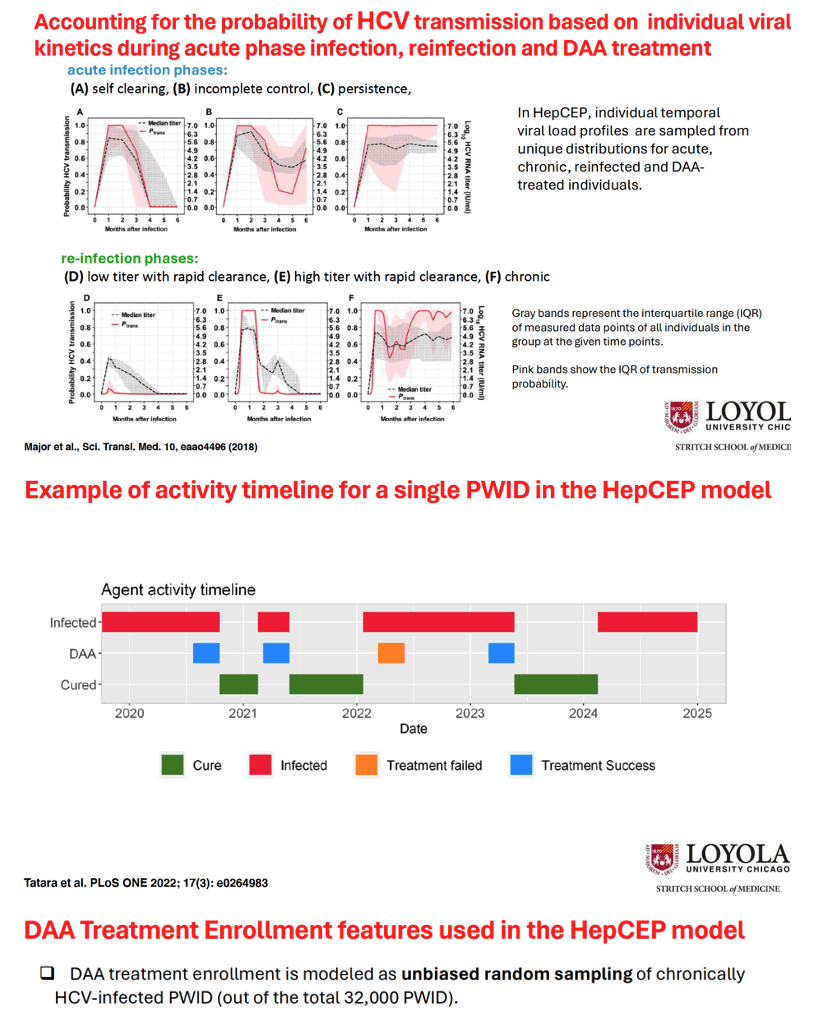
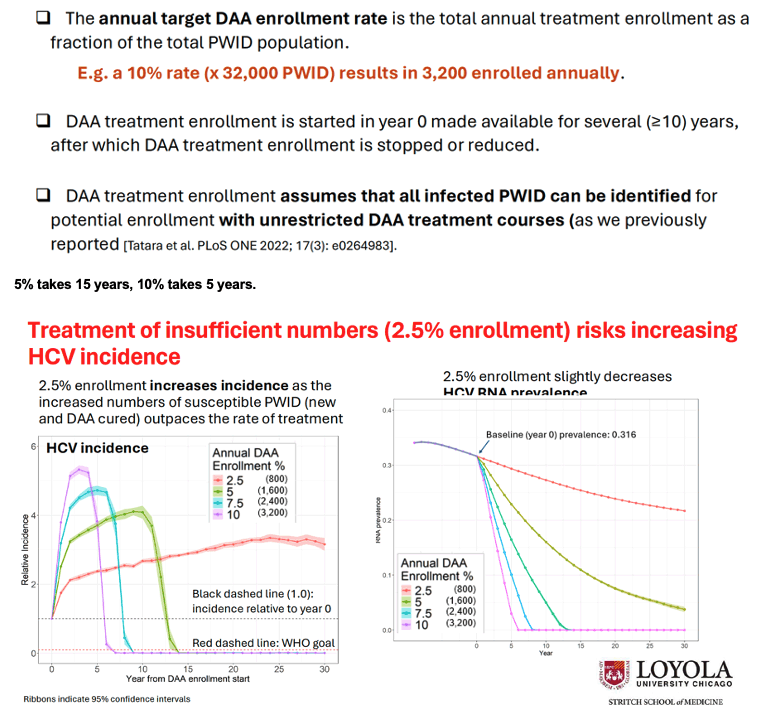
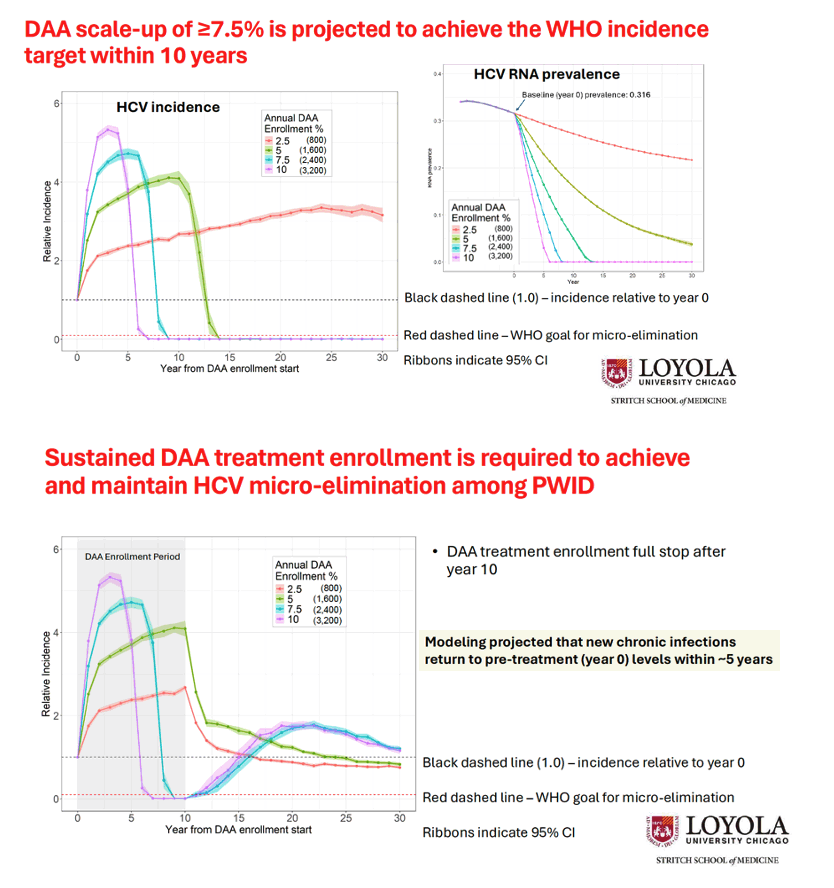
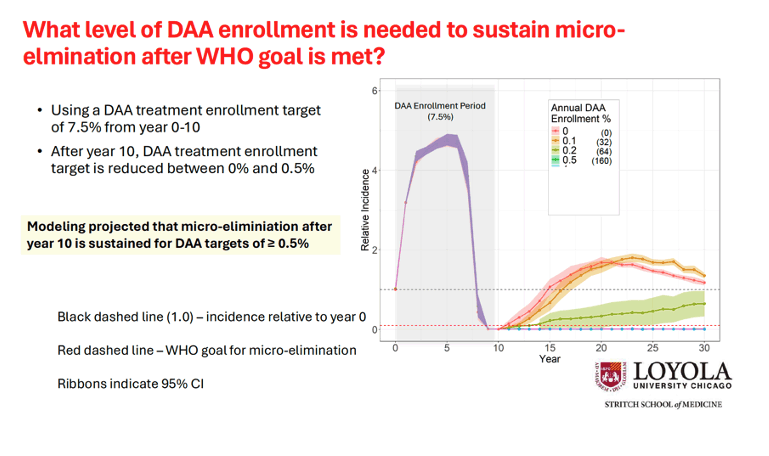
|
| |
|
 |
 |
|
|